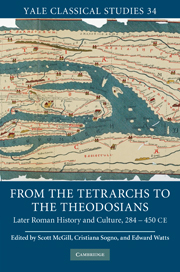Introduction
Published online by Cambridge University Press: 04 August 2010
Summary
One had only to open the pages of Ammianus to see that this was a source for late Roman history that…was a wonderfully effective introduction to a new age, combining the unexpected features of this new age with a more or less traditional way of describing them. After the well-practiced regularities of early imperial history, what was striking about the later Roman empire was its richness and diversity, and its massive and varied documentation; and here was a writer prepared to address it in the familiar terms of the Classical historian.
The work of John Matthews can be described in much the same terms that he uses to introduce the historian Ammianus Marcellinus in the second edition of his book The Roman Empire of Ammianus. Across a long and distinguished career, Matthews has framed late antiquity in classical terms, but with an eye to bringing out the distinctive contours of the new age. Like Ammianus, Matthews never pretends that the structures and routines of the high empire survive unchanged into late antiquity. Yet, again like his most famous subject, Matthews also recognizes the advantages of using classical tools to draw upon the great range and relative abundance of sources available to reconstruct the history of the later empire.
- Type
- Chapter
- Information
- From the Tetrarchs to the TheodosiansLater Roman History and Culture, 284–450 CE, pp. 1 - 10Publisher: Cambridge University PressPrint publication year: 2010



